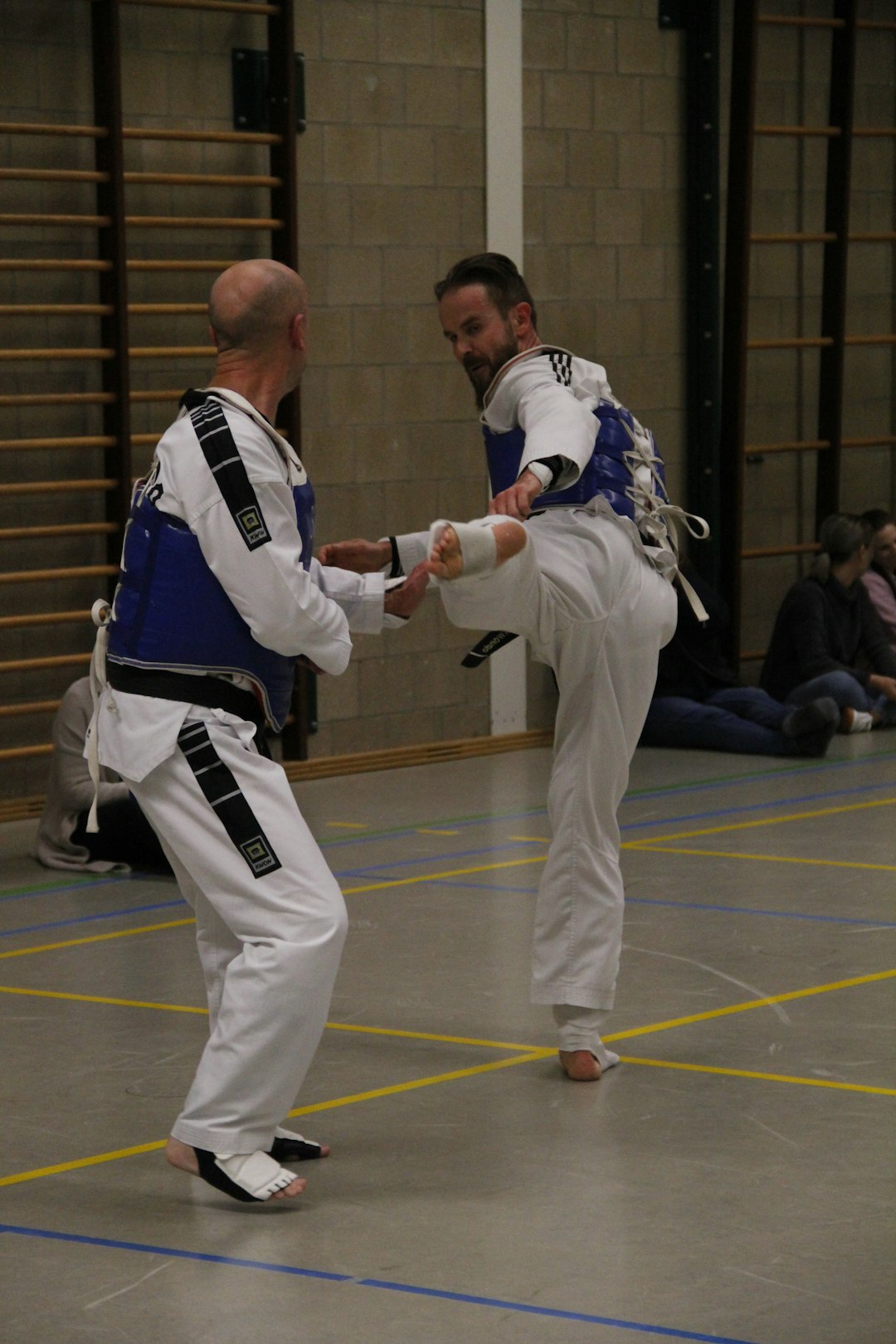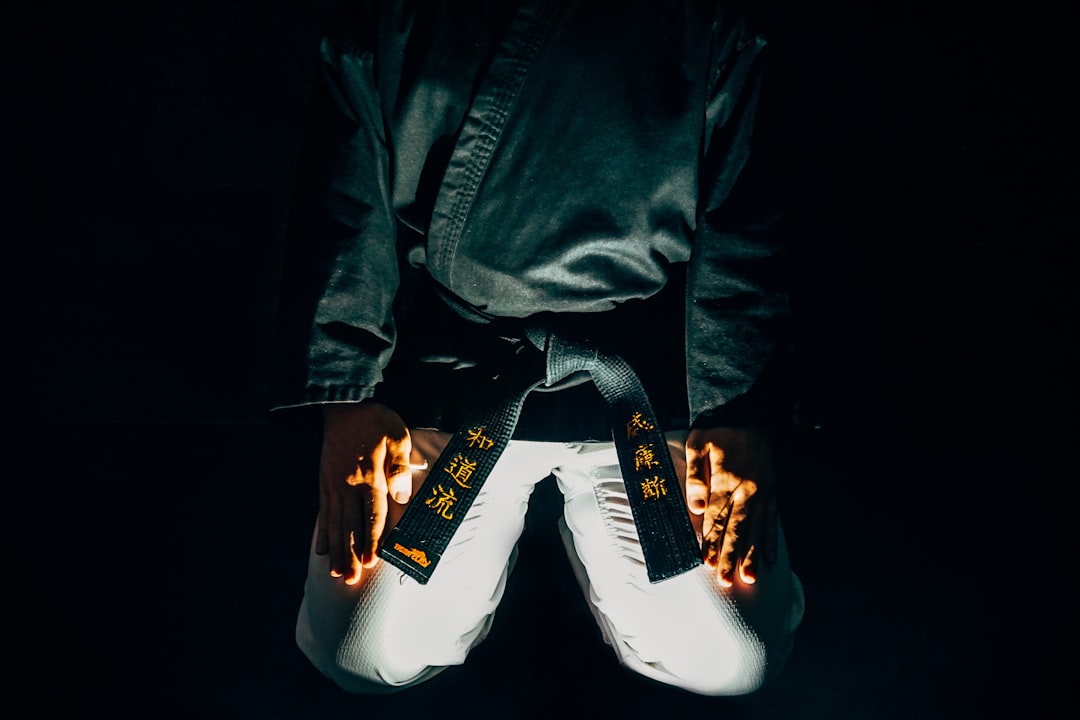The keikogi, also known as karategi, is the traditional attire for karate practitioners, embodying both functional and symbolic significance. It consists of a jacket, trousers, and an obi belt, which not only facilitate unencumbered movement essential for executing karate techniques but also indicate the wearer's rank within the discipline. The white color of the gi represents purity and humility, reflecting karate's core values. For competition, a tighter-fitting gi is worn to allow judges to clearly see techniques, while formal events or demonstrations might call for a keikogi to underscore the gravity of the occasion. Additionally, high-ranking practitioners may wear hakama, a traditional Japanese skirt, which signifies their advanced standing and adds a cultural element. Modern interpretations of these traditional garments have incorporated lighter materials to enhance mobility without sacrificing the historical integrity of karate's attire. The evolution of karate clothes, while maintaining their iconic design, now offers improved comfort and functionality for today's practitioners across various karate styles.
Embarking on an exploration of traditional martial arts, one element that immediately captures attention is the distinct attire worn by practitioners. Often synonymous with the discipline itself, the karate outfit, or as it’s commonly known, the Gi, serves not only as a uniform but also as a symbol of respect and tradition. This article delves into the significance of Karate clothes names and their role in practice, extending to variations and contemporary interpretations that maintain the essence of this ancient art form. Join us as we unravel the layers of significance behind what practitioners don when they step onto the dojo floor.
- Understanding the Essentials: The Significance of Karate Clothes Name
- The Traditional Touch: Gi and Its Role in Karate Practice
- Beyond the Basics: Additional Karate Attire for Different Contexts
- Modern Adaptations: Contemporary Takes on Classic Karate Outfits
Understanding the Essentials: The Significance of Karate Clothes Name

When delving into the practice of karate, one encounters a range of traditional elements that are integral to the discipline. Among these, the garment donned by practitioners holds particular significance. Known as a “keikogi” in Japanese, this is the formal term for karate clothes. This uniform is designed to facilitate movement and provide comfort, allowing the martial artist to execute techniques with optimal efficiency and precision. The keikogi typically features a jacket, trousers, and a belt, each serving a distinct purpose within the practice. For instance, the jacket is constructed to offer mobility without hindering the range of motion needed for various karate moves. The trousers, similarly, are tailored to allow for ease of movement during sparring or kata performance. The belt, or “obi,” signifies the rank of the practitioner and is tied in a specific knot that is both traditional and functional. Understanding the name and purpose of these garments offers insight into the respect and discipline inherent in karate training. Are the keikogi and accompanying accessories essential for practice? Absolutely; they are more than just attire—they are an integral part of the martial artist’s identity, reflecting dedication to the art of karate.
The Traditional Touch: Gi and Its Role in Karate Practice

When engaging in the discipline of karate, practitioners don their traditional attire, known as a “gi.” This garment is central to the practice, providing both functionality and symbolism within the martial art. The gi serves as a uniform that unifies practitioners, emphasizing equality and focus on skill rather than personal distinction. It consists of a jacket, trousers, and a belt, known as a “obi,” which also signifies the wearer’s rank or level within the karate system. The top, typically a lightweight cotton fabric, is buttoned up and fastened with a sash at the waist, while the trousers are straight-legged and cuffed just above the ankle. The choice of color for the gi can vary, but white is commonly preferred as it signifies purity and humility. What is the name of the karate clothes? The karate clothes name is “gi.” How does the gi reflect the values of karate? The gi reflects the values of karate by emphasizing unity among practitioners, focusing on the art itself rather than individual status, and it signifies different levels of skill with its accompanying belts.
Beyond the Basics: Additional Karate Attire for Different Contexts

When discussing karate attire beyond the basic gi, practitioners may encounter various types of clothing tailored for different contexts and purposes. For instance, what are the appropriate karate clothes name for a high-ranking black belt competing in a tournament? In such cases, competitors often wear a competition gi, which is designed to be more form-fitting than a standard gi, allowing for easier movement and assessment of techniques by judges. Additionally, some karateka may opt for a kimono-style jacket, known as a keikogi, during demonstrations or grading sessions, as it signifies a level of formality and respect for the art. These jackets are typically lighter than regular gis and are meant to showcase the practitioner’s skills without unnecessary fabric getting in the way. Are these the only additional karate attire options available? No, there are also hakama, which are divided skirts traditionally worn over the gi by high-ranking belts, especially during formal occasions or demonstrations. The hakama add an element of traditional Japanese culture to the practice and serve as a visual indication of seniority within the karate community.
Modern Adaptations: Contemporary Takes on Classic Karate Outfits

Modern adaptations have led to contemporary takes on classic karate outfits, which are often referred to as ‘keikogi’ or ‘karategi.’ These traditional garments have evolved to meet the needs of modern practitioners while maintaining the essence of the original design. The keikogi, which translates to ‘training clothes’ in Japanese, typically consists of a jacket and trousers made from heavy cotton or hemp fabric, offering both durability and comfort during rigorous training sessions. Modern iterations of these karate clothes often incorporate lighter materials that facilitate greater mobility and flexibility, essential for the dynamic movements in advanced karate techniques. Are the modern adaptations of keikogi still recognizable as traditional karate outfits? Absolutely, as designers have thoughtfully updated the fit and function without altering the distinctive features that define them. The classic white color remains a staple, symbolizing purity and humility, while subtle adjustments in cut and material adapt to the evolving needs of practitioners across various styles of karate.
In conclusion, the term “karate clothes name” encompasses a range of traditional and contemporary attire that play pivotal roles in the practice and culture of karate. From the fundamental Gi, which symbolizes the unity of mind, technique, and spirit, to specialized garments suited for different contexts, the apparel of a karate practitioner reflects both historical significance and functional necessity. As karate continues to evolve, its attire adapts as well, maintaining the integrity of its origins while accommodating modern training methods. Understanding the karate clothes name is not merely about recognizing terminology; it’s about appreciating the deep-rooted traditions and the adaptability inherent in this martial art’s culture. Whether in a traditional dojo or a contemporary gym, the garments worn by practitioners are a testament to their dedication and respect for the art of karate.
